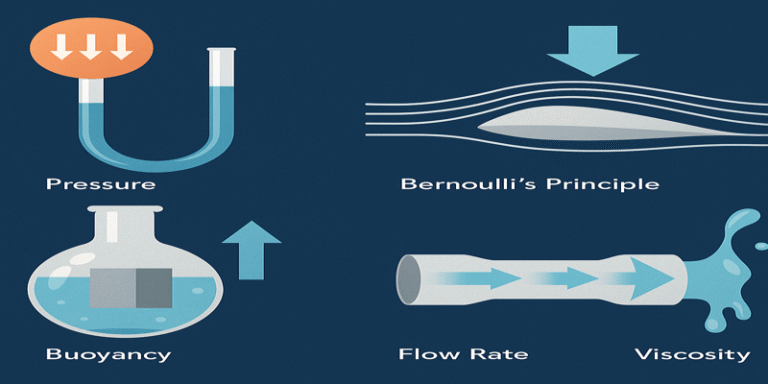Fluid mechanics is a foundational field within classical mechanics that studies the behaviour of liquids and gases under various conditions. As a discipline, it plays a crucial role in many scientific and engineering applications, from weather forecasting to aerodynamics, and from hydraulic engineering to biomechanics. This article introduces the core concepts of fluid mechanics, its historical development, and its broad relevance in both nature and technology.
1.0 What is Fluid Mechanics?
Fluid mechanics is the branch of physics concerned with the mechanics of fluids (liquids, gases, and plasmas) and the forces acting upon them. Unlike solid mechanics, where materials resist deformation, fluids continuously deform when subjected to shear stress (Munson et al., 2013). This property enables the fluid to flow.
The field is broadly divided into two sub-disciplines:
- Fluid statics, which deals with fluids at rest.
- Fluid dynamics, which focuses on fluids in motion.
Each area introduces different concepts and applications, although they both rely on fundamental principles such as pressure, buoyancy, and viscosity.
2.0 Key Concepts in Fluid Mechanics
2.1 Pressure and Pascal’s Law
Pressure is defined as force per unit area and is a key parameter in all fluid-related applications. It is measured in pascals (Pa) in the SI system. A foundational idea is Pascal’s Law, which states that pressure applied to a confined fluid is transmitted undiminished in all directions. This principle is the basis of hydraulic systems like car brakes and presses (Escudier, 2017).
Pascal’s insights revolutionised the understanding of fluid behaviour, enabling technologies that amplify small inputs into large outputs through incompressible fluid systems (Liu, 2021).
2.2 Buoyancy and Archimedes’ Principle
Buoyancy is the upward force experienced by an object submerged in a fluid, resulting from pressure differences on the object’s surface. According to Archimedes’ Principle, a body submerged in a fluid is buoyed up by a force equal to the weight of the fluid it displaces (Charru, 2023). This principle underlies the design of ships, submarines, and even hot air balloons.
Buoyancy has also found increasing application in weather systems, where density differences in air masses cause large-scale atmospheric movements.
2.3 Flow Rate and Continuity Equation
Flow rate quantifies the volume of fluid passing through a cross-section per unit time. The continuity equation, based on mass conservation, states that for an incompressible fluid, the product of cross-sectional area and velocity remains constant along a streamline (Potter & Ramadan, 2025). This law governs water distribution systems, blood circulation, and fuel injection mechanisms.
2.4 Viscosity and Internal Friction
Viscosity is the measure of a fluid’s resistance to flow. In simpler terms, it quantifies how “thick” or “sticky” a fluid is. Honey, for example, is more viscous than water. Viscosity affects the energy required to move fluids and plays a crucial role in lubrication, transport pipelines, and medical diagnostics (Munson et al., 2013).
In engineering, understanding viscosity is essential when designing pumps, turbines, or ventilation systems, as it influences both efficiency and performance.
2.5 Bernoulli’s Principle: Linking Energy and Flow
One of the most celebrated results in fluid mechanics is Bernoulli’s Principle, which states that an increase in a fluid’s velocity leads to a decrease in pressure. This principle can be derived from the conservation of energy and explains how airplanes fly, how carburettors work, and why a shower curtain gets sucked in when water flows rapidly.
In essence, Bernoulli’s equation shows that the total mechanical energy of a fluid particle (kinetic, potential, and pressure energy) remains constant along a streamline (Shaughnessy et al., 2005).
In modern applications, Bernoulli’s principle is used in wind tunnels, venturi meters, and even in natural ventilation systems in buildings (Ghiaus & Allard, 2005).
3.0 Applications of Fluid Mechanics
3.1 Hydraulics
Hydraulics is the application of fluid statics and dynamics to engineering systems involving liquids. Based on Pascal’s principle, hydraulic systems are used in cranes, brakes, lifts, and excavators. They convert small mechanical forces into significantly larger ones with high precision and control (Liu, 2021).
Hydraulic fluids must be chosen carefully based on viscosity, compressibility, and temperature range to ensure safe and effective performance.
3.2 Aerodynamics
Aerodynamics, the study of air in motion, is a vital area within fluid mechanics. It deals with the forces and the resulting motion of objects through air. Applications include aircraft design, wind turbines, sports technology, and vehicle streamlining.
The principles of aerodynamics allow engineers to reduce drag, increase lift, and improve fuel efficiency. High-performance sports like Formula 1 rely heavily on real-time aerodynamic data to optimise performance.
3.3 Meteorology and Weather Prediction
Fluid mechanics is indispensable in meteorology. Atmospheric gases behave like fluids, and their motion determines weather patterns, storms, and climate dynamics. The Navier-Stokes equations, which govern fluid flow, are central to global climate models and regional forecasts (Graebel, 2018).
Phenomena such as jet streams, cyclones, and ocean currents are all governed by the dynamics of fluids, influenced by temperature, pressure, and Coriolis forces due to Earth’s rotation.
3.4 Biomedical and Environmental Engineering
In the biomedical field, fluid mechanics informs our understanding of blood flow, airflow in lungs, and even cell migration. For instance, abnormalities in blood viscosity can lead to cardiovascular complications.
In environmental engineering, fluid mechanics helps model pollution dispersion, groundwater flow, and the aerodynamics of pollutants—vital for managing urban air quality and climate mitigation (Post, 2010).
3.5 Historical Development and Pioneers
The history of fluid mechanics includes contributions from Aristotle, Leonardo da Vinci, Isaac Newton, and Blaise Pascal, among others. However, Daniel Bernoulli and Claude-Louis Navier gave the subject its modern theoretical shape.
The Navier-Stokes equations, developed in the 19th century, form the basis for modern computational fluid dynamics (CFD), a powerful tool used in simulation and modelling of fluid systems (Rathakrishnan, 2022).
4.0 Modern Tools and Research
Today, fluid mechanics has evolved with tools such as CFD software, wind tunnels, and laser Doppler anemometry. These tools enable engineers and scientists to analyse complex flows in real-time, simulate extreme environments, and design systems with high precision.
Research is increasingly focused on microfluidics, turbulent flow modelling, and bio-inspired fluid systems, promising innovations in drug delivery, green energy, and space exploration (Cengel & Cimbala, 2013).
Fluid mechanics is far more than just the study of water and air. It is a comprehensive science that informs the design, operation, and understanding of countless systems across engineering, medicine, environmental science, and meteorology. By grasping core concepts like pressure, buoyancy, flow rate, viscosity, and Bernoulli’s principle, we not only appreciate the physical world around us but also build tools to shape our future. As technology evolves, the relevance and applications of fluid mechanics continue to expand, making it one of the most enduring and impactful branches of physics.
References
Beer, F.P., Johnston, E.R., DeWolf, J.T. & Mazurek, D.F. (2015) Mechanics of Materials. 7th ed. New York: McGraw-Hill Education.
Cengel, Y. & Cimbala, J. (2013) Fluid Mechanics: Fundamentals and Applications. 2nd ed. New York: McGraw-Hill.
Charru, F. (2023) ‘Fluid mechanics in France in the first half of the twentieth century’, Annual Review of Fluid Mechanics, [online] Available at: https://www.annualreviews.org/
Escudier, M. (2017) Introduction to Engineering Fluid Mechanics. London: Oxford University Press.
Ghiaus, C. & Allard, F. (2005) Natural Ventilation in the Urban Environment. London: Earthscan.
Graebel, W. (2018) Engineering Fluid Mechanics. New York: Taylor & Francis.
Liu, P. (2021) A General Theory of Fluid Mechanics. Singapore: Springer.
Munson, B.R., Young, D.F., Okiishi, T.H. & Huebsch, W.W. (2013) Fundamentals of Fluid Mechanics. 7th ed. Hoboken: John Wiley & Sons.
Potter, M.C. & Ramadan, B.H. (2025) An Introduction to Fluid Mechanics. Berlin: Springer.
Rathakrishnan, E. (2022) Encyclopaedia of Fluid Mechanics. Abingdon: Taylor & Francis.
Shaughnessy, E.J., Katz, I.M. & Schaffer, J.P. (2005) Introduction to Fluid Mechanics. New York: Oxford University Press.
Post, S. (2010) Applied and Computational Fluid Mechanics. New York: CRC Press.









